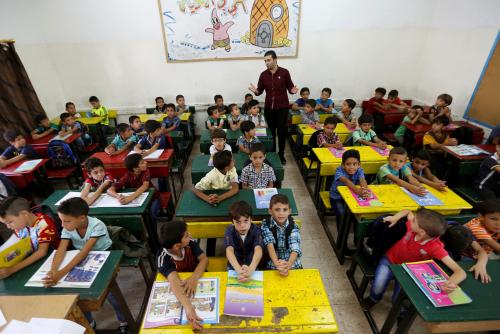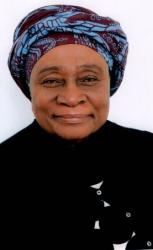This is the third blog post in a series reflecting on key scaling-related themes discussed at the global convening of the Millions Learning Real-time Scaling Labs held in July 2019 in Switzerland.
The Millions Learning Real-time Scaling Lab global convening provided an opportunity to reflect on essential principles for scaling education innovations. One of these principles is the importance of effectively engaging government during the scaling process to impact large-scale systems change. During the convening, ministry of education representatives from Botswana, Cote d’Ivoire, Jordan, the Philippines, and Tanzania contributed valuable insights on this topic. As a senior government official and the permanent secretary for the Ministry of Education (MOE) in Zambia from 1996 to 2004, I reflected on my experience in a significant movement where I played a leadership role: scaling community schools throughout Zambia.
During the 1990s, as Zambia transitioned away from a socialist economy, citizens were increasingly concerned about the large numbers of uneducated young people, so communities began to create their own schools. Over time, these local initiatives grew into a national movement. Today, community schools are an integral part of Zambia’s education system, but it took several stages of partial recognition and 15 years of government collaboration for these schools to be fully recognized in 2011.
In Zambia, the following approaches helped us to create, adapt, and sustainably scale community schools:
- Align with government plans and priorities. Millions Learning research tells us that the essential starting point for government engagement is scaling an innovation that addresses a high priority government issue. In Zambia, it was clear to us in the MOE that community schools addressed a deeply rooted problem: providing affordable access to education for children in the most marginalized communities of Zambia. A key step came when community schools were included in a 1996 MOE policy document legitimizing their role. Following this, a secretariat was established in 1997 to serve as a unified voice for the loose coalition of community members, civil society organizations, and churches that had initiated the movement: the Zambia Community Schools Secretariat (ZCSS).
- Draw on existing structures and include diverse perspectives. ZCSS became the official vehicle to coordinate ideas with government, advocate about the urgent need for community schools, access government funding and other technical support, and present evidence of community schools’ effectiveness to my government counterparts and me. Even though the secretariat was a new one in Zambia—composed of a diverse group of people with different perspectives—the idea of a secretariat was familiar to, and well understood by, government counterparts. This allowed for smooth coordination among my colleagues and me at the MOE with the new ZCSS members.
- Be flexible with implementation approach. One of the reasons community schools have effectively scaled was ZCSS’ willingness to adapt certain aspects of an older model during implementation to gain government support. Specifically, ZCSS had created a “Skills, Participation, Access to Relevant Knowledge” (SPARK) curriculum that compressed the seven-year government primary school curriculum into four years. To become fully integrated in the Zambian education system, however, ZCSS had to abandon aspects of the SPARK curriculum in favor of the government curriculum in community schools. As permanent secretary, I encountered people who argued that community school academic standards were too low and that students from community schools should be ineligible to sit for the primary school completion exams required for transition to secondary school. To address this, ZCSS worked closely with the MOE to identify relevant elements of the SPARK curriculum to incorporate into the government curriculum. To improve teaching, learning, and management standards, we often placed government teachers in community schools and arranged peer support opportunities between government and community school teachers. Through these types of collaboration, government officials and ZCSS members could better understand each other and refine an approach to implementing community schools that brought the greatest benefit to Zambian children.
- Embrace a mindset of experimentation and learning. Learning while scaling, and feeding these insights back into the scaling process, was a key part of the success of the community school movement. Over time, we observed that more resources do not necessarily translate into better results. For example, even though community schools received fewer resources than government schools, many community schools boasted higher student pass rates than those in government schools. Community schools also had a flexible enrollment structure, and effective parental and community engagement. As we witnessed the success of the program, the MOE expanded our support and grew our partnership with ZCSS on many levels. We began to allow community schools to conduct national exams on their own premises, rather than requiring students to travel to government schools (which could be far away and require overnight stays). We also began to provide grants to community schools to improve the quality of education by purchasing books, supporting teacher salary payments, or making infrastructure improvements.
Over time, ZCSS has disappeared since community schools have grown into a national movement and become fully integrated into the national education system. It is no longer a standalone program but simply “the way things are” in the education sector in Zambia. Today, there are more than 3,000 community schools in the country. In recognition of their significant contribution to increased access and quality education, the government provided a legal framework for community schools by including them in the Education Act of 2011 that defined operational guidelines.
I have learned that the journey to scaling education innovations can be a long and challenging one, requiring close collaboration with government and other players to achieve large-scale systems change. In Zambia, I experienced this firsthand and, in my current role as scaling lab advisor in Tanzania, I look forward to bringing my knowledge and experience to bear in supporting the Campaign for Female Education (CAMFED) to scale the Learner Guide program. With the valuable resources and tools available to us from our partners across the Millions Learning Real-time Scaling Labs, coupled with our own personal experiences, we are optimistic about the change we can achieve together in Tanzania.







Commentary
Four key approaches to scaling community schools in Zambia
August 8, 2019